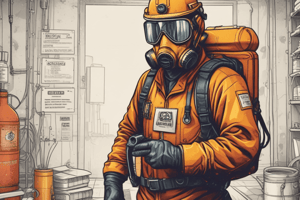Podcast
Questions and Answers
A worker notices a chemical container without a proper WHMIS label in their workplace. What is their MOST appropriate immediate action?
A worker notices a chemical container without a proper WHMIS label in their workplace. What is their MOST appropriate immediate action?
- Ignore the container if they do not regularly use that chemical.
- Create a temporary label based on their best guess of the contents.
- Attempt to identify the chemical by smelling it carefully.
- Report the unlabeled container to their supervisor or employer. (correct)
Which of the following best describes the PRIMARY purpose of WHMIS?
Which of the following best describes the PRIMARY purpose of WHMIS?
- To ensure consistent international regulations for chemical exports.
- To establish a standardized system for classifying workplace hazards.
- To provide a framework for compensating workers injured by hazardous materials.
- To communicate health and safety information about hazardous products to workers. (correct)
An employer is introducing a new cleaning product into the workplace. What are their key responsibilities under WHMIS regarding this new product?
An employer is introducing a new cleaning product into the workplace. What are their key responsibilities under WHMIS regarding this new product?
- Contacting the supplier to negotiate a lower price on the cleaing product.
- Providing worker training, ensuring proper labeling, and making the SDS readily available. (correct)
- Ensuring the product is stored alphabetically with other cleaning supplies.
- Assuming the product is safe if it is a common household cleaner.
A Safety Data Sheet (SDS) contains 16 standardized sections. Which section would you consult FIRST to understand potential health effects of a chemical?
A Safety Data Sheet (SDS) contains 16 standardized sections. Which section would you consult FIRST to understand potential health effects of a chemical?
Under WHMIS 2015, what is the significance of incorporating the Globally Harmonized System (GHS)?
Under WHMIS 2015, what is the significance of incorporating the Globally Harmonized System (GHS)?
A worker is tasked with disposing of a waste container containing a mixture of chemicals. According to WHMIS, what information should be readily available to them?
A worker is tasked with disposing of a waste container containing a mixture of chemicals. According to WHMIS, what information should be readily available to them?
If a supplier discovers significant new information about a hazardous product, how quickly must they update the SDS?
If a supplier discovers significant new information about a hazardous product, how quickly must they update the SDS?
Which of the following is NOT a required element on a WHMIS 2015 label?
Which of the following is NOT a required element on a WHMIS 2015 label?
What is the key difference between 'education' and 'training' in the context of WHMIS?
What is the key difference between 'education' and 'training' in the context of WHMIS?
Why is it important for workers to participate actively in WHMIS training programs?
Why is it important for workers to participate actively in WHMIS training programs?
Which of the following pictograms indicates a health hazard such as carcinogenicity or respiratory sensitization under WHMIS 2015?
Which of the following pictograms indicates a health hazard such as carcinogenicity or respiratory sensitization under WHMIS 2015?
What is the PRIMARY responsibility of suppliers under WHMIS regarding hazardous products?
What is the PRIMARY responsibility of suppliers under WHMIS regarding hazardous products?
Which of the 16 sections in an SDS would contain information about proper spill clean-up procedures?
Which of the 16 sections in an SDS would contain information about proper spill clean-up procedures?
A worker notices that their workplace's WHMIS program is outdated and doesn't reflect current regulations. What is the MOST appropriate action to take?
A worker notices that their workplace's WHMIS program is outdated and doesn't reflect current regulations. What is the MOST appropriate action to take?
A worker is unsure about the meaning of a specific hazard pictogram on a chemical container. Where should they FIRST look for clarification?
A worker is unsure about the meaning of a specific hazard pictogram on a chemical container. Where should they FIRST look for clarification?
Under WHMIS, what is the definition of a 'hazardous product'?
Under WHMIS, what is the definition of a 'hazardous product'?
How does effective hazard communication, as promoted by WHMIS, benefit a workplace beyond simply complying with regulations?
How does effective hazard communication, as promoted by WHMIS, benefit a workplace beyond simply complying with regulations?
Which hazard class includes materials that can cause immediate and severe harm to living tissue upon contact?
Which hazard class includes materials that can cause immediate and severe harm to living tissue upon contact?
What should a worker do if the signal word on a WHMIS label is 'Danger'?
What should a worker do if the signal word on a WHMIS label is 'Danger'?
What Pictogram indicates the presence of material which present Acute Toxicity?
What Pictogram indicates the presence of material which present Acute Toxicity?
Flashcards
What does WHMIS stand for?
What does WHMIS stand for?
Workplace Hazardous Materials Information System; a Canadian system for providing safety information on hazardous products.
What is hazard identification?
What is hazard identification?
Identifying the hazards associated with controlled/hazardous products, based on Hazardous Products Regulations (HPR).
What is product classification?
What is product classification?
Organizing hazardous products into groups based on the type and severity of their hazards.
What information is on WHMIS labels?
What information is on WHMIS labels?
Signup and view all the flashcards
What are Safety Data Sheets (SDS)?
What are Safety Data Sheets (SDS)?
Signup and view all the flashcards
What is worker education and training?
What is worker education and training?
Signup and view all the flashcards
What is WHMIS 2015?
What is WHMIS 2015?
Signup and view all the flashcards
Examples of physical hazards?
Examples of physical hazards?
Signup and view all the flashcards
Examples of health hazards?
Examples of health hazards?
Signup and view all the flashcards
What are the responsibilities of suppliers?
What are the responsibilities of suppliers?
Signup and view all the flashcards
What are the responsibilities of employers?
What are the responsibilities of employers?
Signup and view all the flashcards
What are the responsibilities of workers?
What are the responsibilities of workers?
Signup and view all the flashcards
What are pictograms?
What are pictograms?
Signup and view all the flashcards
Examples of WHMIS pictograms?
Examples of WHMIS pictograms?
Signup and view all the flashcards
Who enforces WHMIS?
Who enforces WHMIS?
Signup and view all the flashcards
How to stay WHMIS compliant?
How to stay WHMIS compliant?
Signup and view all the flashcards
Study Notes
Key Components of WHMIS:
- Hazard identification determines hazards of products based on Hazardous Products Regulations (HPR) criteria.
- Manufacturers and suppliers are responsible for hazard identification
- Product classification involves organizing hazardous products into hazard classes and categories.
- Hazard classes and categories dictate hazard type and severity.
- Labels for hazardous products must contain: product identifier, supplier identifier, hazard symbols, signal word, hazard statement(s), precautionary statement(s), and supplemental information.
- Safety Data Sheets (SDS) are detailed documents with 16 standardized sections, available to workers, and updated every three years or when significant new information arises.
- Worker education and training programs, provided by employers, cover WHMIS regulations, hazard classes, labels, SDSs, safe handling, emergency procedures, and PPE.
- Education provides general WHMIS information, while training is product and task-specific.
WHMIS 2015:
- WHMIS 2015 incorporates the Globally Harmonized System of Classification and Labelling of Chemicals (GHS).
- GHS is an international system standardizing hazard communication.
- WHMIS 2015 adopts GHS hazard classes, categories, and pictograms.
- The Hazardous Products Regulations (HPR) were updated to align with GHS.
- Labels, SDSs, and worker education/training remain core elements of WHMIS 2015.
Hazard Classes:
- WHMIS 2015 uses hazard classes to group products with similar hazards.
- Physical Hazards include flammable substances, explosives, oxidizing substances, gases under pressure, and corrosives to metals.
- Health Hazards include acute toxicity, skin/eye damage, sensitization, mutagenicity, carcinogenicity, reproductive toxicity, target organ toxicity, and aspiration hazard.
- Environmental Hazards include hazards to the aquatic environment.
Roles and Responsibilities:
- Suppliers classify products, prepare labels/SDSs, and provide them to purchasers.
- Employers ensure proper labelling, obtain/provide SDSs, offer worker training, and implement protective measures.
- Workers participate in training, follow procedures, use PPE, and report hazards.
Benefits of WHMIS:
- WHMIS reduces workplace incidents, improves hazard awareness, standardizes communication, promotes safer handling, and facilitates regulatory compliance.
Enforcement:
- Federal, provincial, and territorial agencies enforce WHMIS via inspections, and non-compliance can result in penalties.
Staying Compliant:
- Compliance requires regular program reviews, up-to-date and accessible SDSs, regular training, proper labelling, and fostering a safety culture.
Importance of Pictograms:
- Pictograms are graphic symbols on labels/SDSs that quickly communicate hazards.
- Nine pictograms defined under WHMIS 2015 represent flammability, oxidizers, explosives, gases under pressure, corrosives, acute toxicity, health hazards, irritants, and environmental hazards.
Review and Updates:
- WHMIS is regularly reviewed/updated with stakeholder participation, and updates are communicated through various resources.
Studying That Suits You
Use AI to generate personalized quizzes and flashcards to suit your learning preferences.




